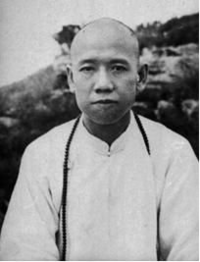Views
Hán Qīngjìng 韓清淨 (1884-1949)
|
| Notable Associates: |
|
Hán Qīngjìng 韓清淨 (1884-1949) was a well known Northern lay scholar of Consciousness-Only 唯識, often paired with Ōuyáng Jìngwú 歐陽竟無 as one of the greatest scholars of that philosophy during the Republican period. This reputation is exemplified by the phrase Nán Ōu běi Hán 南歐北韓, "In the South, Ōu(yáng), in the North, Hán."
Contents |
Biography
Hán was from a literati family, and attained the Xiùcái 秀才 degree at a young age. In 1902, he received the Jǔrén 舉人 degree. This was about the time when the examination system was about to be abolished, and Hán turned his energies to studying Buddhism. He began with the Chéng wéishì lùn 成唯識論 and the Yúqiē shīdì lùn 瑜伽師地論 (Yogācāra-bhūmi-śāstra), but could make neither ends nor tails of them.
In 1921, he formed the Dharmalakṣaṇa Research Association 法相研究會 in Běijing 北京 with Zhū Fèihuáng 朱芾煌, Hán Zhéwǔ 韓哲武, Xú Sēnyù 徐森玉, and Ráo Fēnghuáng 饒風璜. Hán eventually took up residence at at Yúnjū Temple 雲居寺 in Fángshān County 房山縣, where he practiced in sealed confinement for three years.
From October 1 to 3, 1925, he went to Tokyo as part of the twenty-six person Chinese delegation to the East Asian Buddhist Congress 東亞佛教大會. Other participants included with Tàixū 太虛, Dàojiē 道階, and Wáng Yītíng 王一亭.
In 1927, Hán, Zhū Fèihuáng, Xú Sēnyù, and Ráo Fēnghuáng formed another group, the Study Group of the Three Times 三時學會, which was dedicated to the practice and study of Indian Buddhism, as well as the translation and printing of Buddhist scriptures. Hán lectured at the study group once every week, he also lectured on Dharmalakṣaṇa at various colleges around Běijīng.
In 1928, he was invited to give a lecture series on Consciousness-Only at Beijing University. There he spoke of the importance of Xuánzàng 玄奘. He also lectured at Guǎngjì Temple 廣濟寺.
Important Works
- 般若波羅密多心經略贊
- 成唯識論講義
- 大乘阿毗達磨集論別釋
- 佛法略談
- 解深密經分別瑜伽品略釋
- 能斷金剛經了義疏
- 攝大乘論科文
- 十義量
- 唯識論述記講義
- 唯識三十論略解
- 唯識三十頌詮句
- 唯識指掌
- 因明入正理論科釋
- 瑜伽師地論科句披尋記
Notable Students
- Zhū Fèihuáng 朱芾煌
References
- Shì Dōngchū 釋東初. Zhōngguó Fójiào jìndài shǐ 中國佛教近代史 (A History of Early Contemporary Chinese Buddhism), in Dōngchū lǎorén quánjí 東初老人全集 (Complete Collection of Old Man Dongchu), vols. 1-2. Taipei: Dongchu, 1974 Pp. 2.671-673.
- Yú Língbō 于凌波, ed. Xiàndài Fójiào rénwù cídiǎn 現代佛教人物辭典 (A Dictionary of Modern Buddhist Persons), 2 vols. Taipei: Foguang, 2004. Pp. 2.1680a-1682b.
